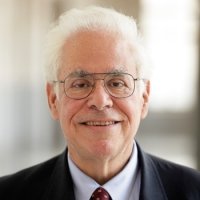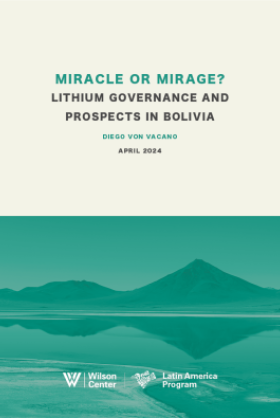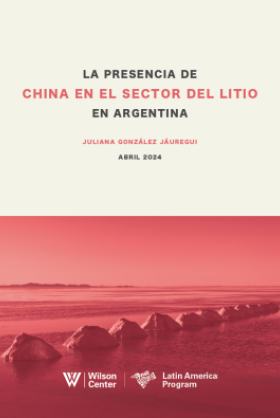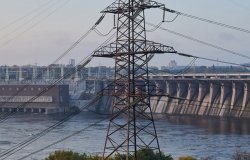Secretary of Energy Ernest Moniz on 2015 Global Policy Outlook
On Wednesday, January 7, 2015, Secretary of Energy Ernest Moniz will keynote an event at the Wilson Center entitled “2015 U.S. Energy Policy Outlook: Opportunities and Challenges”. An additional panel of experts from academia, government and the private sector will discuss current global challenges and opportunities in energy markets and politics.
Overview
The Wilson Center’s Regional and Global Energy Series continued January 7 with its signature event, hosting a panel of experts from academia, government, and the private sector to weigh-in on key global energy developments in 2014 and provide forecasts for the new-year. Additionally, keynote speaker Secretary of Energy Ernest Moniz addressed the Department of Energy’s 2015 priorities, highlighting advances in the White House’s Climate Action Plan and the forthcoming Quadrennial Energy Review.
Secretary Moniz gave his keynote remarks following the global energy panel discussion and a brief segue from Director, President and CEO of the Wilson Center, Jane Harman. He began by highlighting progress on the 3 pillars of the Climate Action Plan – mitigation, adaptation, and international cooperation. Moniz announced major programs for 2015, including the third “open solicitation”, building on ARPA-E, with $125 million allotted for novel clean technology ideas and an expansion of DOE’s Loan Program with $40 billion to aggressively deploy new and cleaner technologies in all forms of energy and efficiency. Moniz also announced that planned efficiency standards are projected to result in a 3 gigaton reduction of CO2 emissions, saving nearly half a trillion dollars for consumers.
On international cooperation, DOE’s focus of 2015 will be furthering cooperation with China on joint CO2 commitments, and additional trilateral discussions with Mexico and Canada to improve North American infrastructure and policy integration. Moniz supported further collaboration on energy security between the U.S. and G7 allies and friends in Europe – “even if we are tempted to have a complacent view of energy security in the United States because of our production, the fact remains that we have a serious interest in the broader energy security issue with our allies and friends. It has huge geopolitical implications for us”.
As a preview for the forthcoming Quadrennial Energy Review, Moniz summarized its structure in 4 main areas – modernization of the Strategic Petroleum Reserve, integrating data technology in the Smart Grid, improving resilience of the U.S. energy infrastructure, and improving shared infrastructures (especially railways and inland waterways).
Moniz’s keynote address and the expert panel discussion were the signature event in the Regional and Global Energy Series, which hosts, throughout 2014 and 2015, bimonthly regional energy discussions in close coordination with the Wilson Center’s regional programs. Public Policy Scholar and energy lead, Jan H. Kalicki moderated the panel discussion and Q&A following Secretary Moniz’s remarks.
The series follows the framework of the 2013 book Energy and Security: Strategies for a World in Transition, co-edited by Kalicki and David L. Goldwyn and now in its second printing, which calls for the establishment of a global energy security system (GESS) to replace the currently outdated international energy system. Kalicki presented the 5 main pillars of the GESS strategy:
1) Propagate the unconventional energy revolution abroad
2) Create a global natural gas market
3) Forge greater coordination of emergency response measures
4) Lead a multilateral effort to end energy poverty
5) Commit to global engagement and the protection of sea lanes
Kalicki argues “with the shift of global energy balance from East to West, and the advent of lower oil prices, we have an opportunity to make real progress on this agenda, and more broadly on energy, environment, and technology issues”.
Edward L. Morse referenced his chapter in Energy and Security, which virtually predicted the decline of OPEC as a consequence of structural changes in world energy production, resulting from volatile oil prices and new technologies. These developments revolutionized oil production in many parts of the world, most dramatically in North America, and reduced the ability of OPEC to control prices. Considering the new energy landscape, Morse described 3 trends in the world crude oil market entering 2015: 1) increased world GDP growth (possible 0.8% increase by 2016) spurred by low oil prices, 2) continued U.S. shale development in the first half of 2015 (1 million bbl/d annual growth rate until CAPEX reductions begin slowing growth), and 3) decreasing Saudi market share (last 3 months of 2014, Saudi exports were half that of the last 3 months of 2013). The oil market will balance eventually, according to Morse – “nothing cures low prices like low prices”. However, in the coming months, the combination of these trends will cause significant market and geopolitical disruptions.
Energy Secretary Moniz would later agree in his keynote, stating that low prices will only temper U.S. oil production in 2015 from the previously expected 9.5 down to 9.3 million bbl/d, depending on how long low prices persist and CAPEX reductions. He added that geopolitical consequences will challenge countries dependent on high oil prices.
Developing a transatlantic energy relationship is essential for us to mitigate the effects of these disruptions, according to Ana de Palacio, who stated, “For strategic reasons, energy creates a raison d’etre for transatlantic negotiations”. An energy chapter in the planned Trans-Atlantic Trade and Investment Partnership (TTIP) would be an opportunity to decrease Europe’s external energy dependence and provide long-term energy security. However, Palacio notes there are significant international and domestic challenges before this becomes reality, including nationalized energy policies in the EU and legal differences between the U.S. and EU.
With all the global disruption, Goldwyn warned that U.S. energy policy must avoid complacency with current levels of oil production. He suggested 5 steps for the U.S. to implement domestically to plan for the end of this oil market cycle: 1) invest in infrastructure (pipelines to connect energy sources to markets), 2) market-based approach to the environment (revenue neutral carbon tax), 3) invest in R&D (battery storage and carbon sequestration), 4) sustain production growth (allow energy exports), and 5) address the climate repercussions of increased production (methane and volatile organic compounds or VOCs). For U.S. international energy, Goldwyn recommended helping governments create the legal frameworks necessary for extending the unconventional oil revolution abroad, working with G7 partners to create a competitive international natural gas market, considering special drawing rights from the US strategic petroleum reserve, and formulating a cohesive global energy policy across the Federal Government.
As Jane Harman noted, forecasting the direction of global energy markets is no easy task, and market prices only provide a surface understanding of the complexities of international energy. To better understand these complexities heading into the new-year, Secretary Moniz and the other panelists’ remarks at the Wilson Center’s January 7th event provided deep insight and an open dialogue for actionable ideas on the challenges and opportunities facing global energy markets and governments.
Speakers
The Hon. Ernest Moniz
Ana de Palacio
David L. Goldwyn

Jan H. Kalicki
Counselor for International Strategy, Chevron; Chairman, Eurasia Foundation
Edward L. Morse
Thank you for your interest in this event. Please send any feedback or questions to our Events staff.










